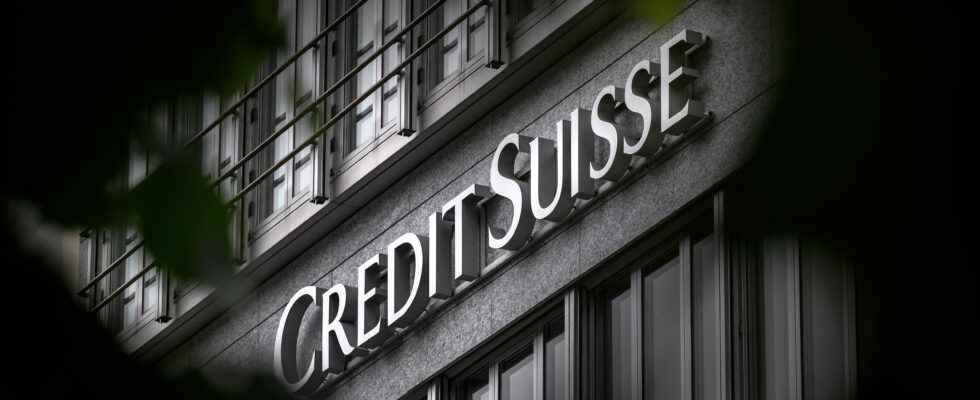(BFM Bourse) – Concern about the situation of Credit Suisse has revived the scenario of a Lehman Brothers, which caused the economic crisis of 2008. For many observers in the world of finance, these fears are unfounded. European banks are indeed much more armed than in 2008, driven by stricter capital regulations.
The setbacks of Credit Suisse, shaken by a series of scandals and whose stock market value has been divided by three in a year and a half, revive the specter of the first major victim of the financial crisis of 2008-2009, the bank American Lehman Brothers.
For nearly three weeks, its share price has been sinking to low point after low point as rumors swirl around the approach of a balance sheet on its strategy. Considered a restructuring specialist, its new managing director, Ulrich Körner, was given the heavy task at the start of August of carrying out a strategic review to turn the bank around, on which he is due to take stock on October 27.
But last week, credit default swaps jumped. These derivatives are used by investors to protect themselves against the risks of non-repayment of a debt, their rise meaning that investors demand more guarantees for the obligations linked to Credit Suisse.
A price at a historic low
On Monday, the action of the number two in the Swiss banking sector fell by nearly 11.5% in the first exchanges, reaching a new historic low point at 3.518 Swiss francs after a new round of rumors during the weekend. The title finally closed down a little less than 1%, at 3.94 CHF.
On social networks, discussions around a “Lehman Brothers moment”, in reference to the American bank which had gone bankrupt in 2008 and marked the outbreak of the great financial crisis, spread like wildfire, even if many observers in the world of finance dismiss this risk.
For the European Systemic Risk Board (ESRB), attached to the ECB, the second Swiss bank and the European banking system as a whole are better equipped than at the time to deal with a crisis.
Why is Credit Suisse’s situation worrying?
By letting Lehman Brothers sink in 2008, the Bush administration hoped to set an example, without having measured all the consequences. The establishment’s bankruptcy thus led market players to think that other establishments could follow, accentuating the difficulties and requiring the intervention of many States. The Belgian-Dutch holding company Fortis was thus dismantled, the Belgian subsidiary coming under the control of the French BNP Paribas.
Especially many other institutions, considered “too big to fail” (too big to fail) had to be rescued urgently, at the risk of a complete collapse of the financial system. The American insurer IAG or the Franco-Belgian bank Dexia, which ultimately did not survive the Greek debt crisis, were among the establishments rescued.
However, these rescues were very costly for public finances and triggered the debt crisis that followed and led to an austerity cure, particularly in Europe.
Tests to measure the soundness of banks
Under pressure from the European regulator, banks have made significant efforts over the past decade to be more robust in the event of a crisis. For example, they must demonstrate a higher minimum level of capital intended to absorb any losses. This hard capital ratio, also called CET1, is the work of the Basel Committee in Switzerland.
Credit Suisse posted in its mid-year results, published at the end of July, a solvency ratio of 13.5%. By way of comparison, it is 12.2% for BNP Paribas, 14.93% for the Italian Unicredit and 13% for Deutsche Bank.
This capital ratio, which makes it possible to cope with unexpected losses, was “strongly reinforced” after the 2008 crisis, assures the head of the Paris banking team at the rating agency Moody’s Alain Laurin, and the way to calculate has been amended in a more restrictive sense.
The European Banking Authority is also subjecting fifty major banks on the continent to stress tests. The results for the last financial year, published at the end of July 2021, showed that the establishments were well able to withstand a serious economic crisis without too much damage.
A new domino effect to fear?
The experts contacted by AFP want to be reassuring for the moment. First, Credit Suisse “remains a solid financial institution”, says Guillaume Larmaraud, partner in charge of financial services at Colombus Consulting.
Then, even in the event of a crisis, “the financial solidity of the banks is extremely strong, the lessons of 2008 have been well learned,” said Vanessa Holtz, head for France of Bank of America, to AFP. In the event of the failure of a banking player, the European continent “now has a framework” to get it out of the rut, whatever its size, supplemented in February the president of the Spanish bank Santander Ana Botín, also president of the European banking lobby.
And if, as a last resort, governments were tempted to take out the wallet to save an establishment, unlike the situation before 2008, a framework initially provides for making shareholders or the largest creditors pay. The banks also contribute to a European fund which must avoid presenting too heavy a bill to taxpayers.
(With AFP)
SS – ©2022 BFM Bourse
